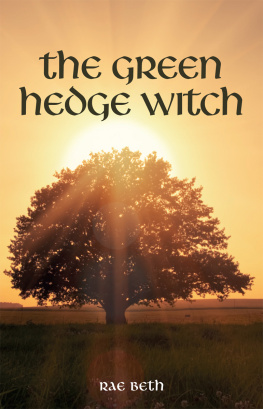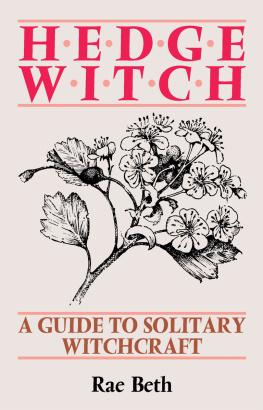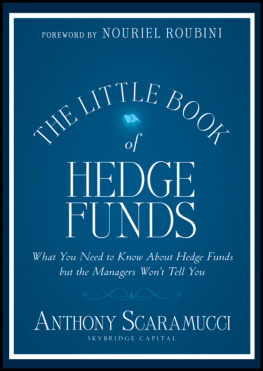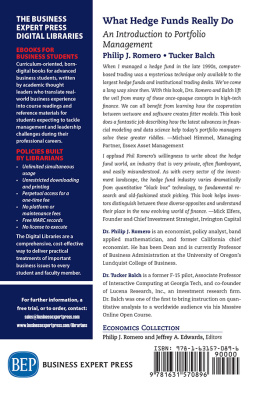Moon Books invites you to begin or deepen your encounter with Paganism, in all its rich, creative, flourishing forms.
1
What do Hedge Witches Do?
As a hedge witch, your personal interests may include nature, herbs, folk magic, divination, healing and most particularly, hedge riding. Similar to most pagans, you will carefully watch the seasons change and celebrate them with festivities, from the first signs of rebirth in the spring to the ripeness of summer, to the collecting in of the sustainable harvest, and the resting period of the dark winter months. You will most likely follow the waxing and waning of the moon and tides and do not wish for the end of one season and reject the start of another often with negativity (as with winter), but accept each one and attempt to flow with them.
As an animist and pantheist, you may see divinity in all things without and within with a guardian spirit inhabiting each lake, stream, hill and mountain, plant and tree.
As a solitary witch, you do not have to be lonely and so there is no need to confine yourself to the house and secretly go about your witchy business. You can network regularly with other witches and pagans and meet up with them when you can. You can perhaps attend moots, rituals and gatherings and share your experiences with others. Maybe swap recipes for herbs and wildflowers, swap seeds and superfluous plant cutting, and learn new methods and new ways of cooking more healthily. The benefits though of hedge witchery is being able to do your own thing, such as growing herbs and vegetables, or walking out in nature to talk to nature spirits, or to watch the wildflowers appear and collect items for the occasional folk spell.
As a hedge witch, it is better to go out and experience nature than sit in, think and read constantly. A sense of place is therefore paramount to spirituality. There is nothing better than to detach yourself from the busy, noisy and crowded towns, and lose yourself in the tranquility and the almost surreal, non-materialism of the landscape. You will find a natural sacred space within the forest, on the hill or close to the lake. While lost in your landscape, and quoting a dear friend the late academic and poet Dr Edmund Cusick, you may well experience the same feeling:
I still feel essentially lifted up in spirit when I pull up at the head of the Glen, get out and breathe in. It is mountain country, as surely as the Cairngorms is the absolute sense that this is no longer human territory, but the territory of the wilderness, that the animals, the trees, are the natural inhabitants and that we do not primarily belong there.
(Between Field and Stars, Headland 2008)
When we are in the countryside we too, often, feel the wild otherness of the spirit there, and that we are privileged to be there but then this is the natural and magical territory of the hedge witch, so we stay.
The Lake
Thistles and nettles scratch at my legs
impeding my progress, as I find my hillside settle.
Ahead the sun strikes stone, through the ash tree,
a dazzling diamond, reflecting in the smoothness of the lake.
Echoing in the distance is the flap of a swans wings
as it flails in reeds, and the blatant buzz of the fly
as it catches in my tangled hair.
Barbed whitethorn stands queenly among weeds,
where swallows swoop, while blue damsel hovers
around solitary rose, lost in the gamut of greenness.
Glass hills sit neatly on the horizon like a childs drawing,
distant, unreal, unreachable.
I see the river as it leaves the lake,
winding to the land of possibilities,
open to all who seek.
I see the wind now as it blows like waves of horizontal
rain pouring across forbidden landscape.
Sentinel whitethorn scatters her offspring below,
watching. I hear the wind whisper, trees talking,
birds singing as the swan princess glides
over the rippling slate, where her human lover awaits.
Silky sylphs veiled in feathered cloud
float in and out of the blue. Fabled fairy sails
around my feet, beckoning as the wind blows
her to the tree of life and her dazzling diamond.
Solitary wild rose her pretty head bowed, reaching
seeking.
I reach out and touch the hills.
Connecting with Nature
Connecting with nature is becoming a part of it. It is the need to see yourself as a small part of the whole of nature and it will make all the difference to the way you not just view but see things. See the landscape as Edmund saw it, and observe the absolute sense that it is no longer human territory. Lose yourself in the landscape. See nature as belonging to no one, owned by none, not by the farmer or the landowner, the inhabitant, or the state or country. Nature exists above and beyond the land. Land may be territory but nature is spirit, nature is free, uncontrollable, mutable, wild, serene, terrifying, beautiful, devastating, magnificent, joyful, destructive, and life-giving. Loving nature is accepting the wild along with the serene, the destructive along with the life giving aspects of it.
When people say they pit themselves against nature, perhaps mountain climbing or white water rafting, they cannot actually control or conquer nature, only survive it. However, in doing so they become a part of nature and they go with it adapt to it, rather than go against it. They are companions to nature. When we walk in the fields or paddle in the stream we can also be a companion adapt ourselves to our surroundings, and become a part of and go with nature, without putting ourselves at risk I might add.
When out in nature employ all your senses. Look around you and see . By see, I mean really look to see what is there. You will be surprised at what you miss when you walk and your mind wanders to everyday matters. Keep your concentration, look at everything, and acknowledge what you see. Look at the texture of the bark or leaves, the different shades of green, the breeze kissing the blades of grass, the trout meandering in the stream, and the squirrel scurrying up the tree trunk. Listen to the tinkling of the water as it musically winds its way down the rocks, or the birds singing, trees whispering or the ocean sighing.
When you touch something, you directly connect with it. Feel the rough bark of the tree, or the velvet of the rose petal. Feel the breath of wind in your hair, or the coldness of the water as you dangle your feet in the stream, or the softness of the grass as you run barefoot in the meadow.
Hum, sing or whistle as you join the sounds of nature.
Sense the spirit of place, the spirit in the mountain, the spirit in the stream, the spirit in the tree or rock.
Over the years, you may have never connected with nature owing to modern demands on your time and person. As a result, you may well have drawn a line between nature and yourself. Therefore, when you travel through the countryside, to the park, or even if you step into your garden, you see it all as something separate, like a theme park you visit and then leave. Try to remove that line that lies between you and the hills, the lakes, rivers and oceans, the trees, the flora and fauna, the rose and the song thrush or at least blur it. Step into the inside instead of on the outside looking in. The exercise below is designed to help you do just that.
Exercise
Shapeshift into nature by becoming what you see. See the tree and become it by slipping into it so that your legs and feet become the roots, your body the trunk and your head the branches. Feel and hear what is going on inside you, the sap rising, the insects burrowing, the wind swaying your branches and rustling your leaves.










